| Reviews & Columns |
|
Reviews DVD TV on DVD Blu-ray 4K UHD International DVDs In Theaters Reviews by Studio Video Games Features Collector Series DVDs Easter Egg Database Interviews DVD Talk Radio Feature Articles Columns Anime Talk DVD Savant Horror DVDs The M.O.D. Squad Art House HD Talk Silent DVD
|
DVD Talk Forum |
|
|
| Resources |
|
DVD Price Search Customer Service #'s RCE Info Links |
|
Columns
|
|
|
Karate Kid Collection, The
The complete adventures of Daniel-San and Mr. Miyagi
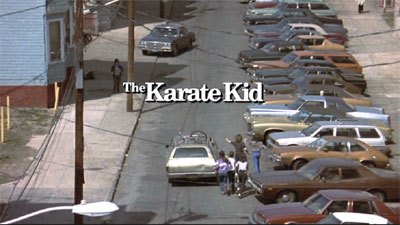
The Movies
Probably one of the most successful sports-film franchises in American film, the Karate Kid movies combine the underdog genre with martial arts to create a sure-fire idea, powered by director John Avildsen (Rocky) and writer Robert Mark Kamen (The Fifth Element.) The first three films follow the maturation of young Daniel LaRusso (Ralph Macchio), a Jersey kid with a chip on his shoulder, who was forced to move to California. Without any friends, he finds his new life a struggle, filled with bullies. Then he meets Mr. Miyagi (Pat Morita), a sage handyman who teaches him how to defend himself and become a champion. The fourth film gives Miyagi a new charge, a teenage girl named Julie (Hilary Swank) with a chip on her shoulder.
There's nothing groundbreaking about these films, but by placing plenty of focus on the Miyagi/Daniel-San relationship, one between a teacher and student, a surrogate father and son, there's more depth than your average sports flick. Add in the subplot of Miyagi's own life experiences as a soldier and husband, and the films become the kind of entertainment that's more fulfilling than the usual fluff.
The Karate Kid: A true classic, this story of a young kid taught to harness his mind and body kicked off a karate phenomenon in America, and introduced the crane kick and the chore method of karate teaching, as Daniel-san washed cars, painted fences and sanded decks in a subconscious instruction method. The general plot centers around Daniel's misfortunes in adjusting to California life after a New Jersey childhood. He has the misfortune of getting interested in Ali (Elizabeth Shue), whose ex-boyfriend is the local karate champ, Johnny Lawrence (William Zabka.) Obviously, this doesn't sit well with Johnny, who, with the help of his sensei, the maniacal John Kreese (Martin Kove), organizes a campaign of terror on Daniel with his karate posse, the Cobra Kai. Mr. Miyagi helps Daniel by first focusing his mind through bonsai (the small trees) and then teaching him how to best fight back.
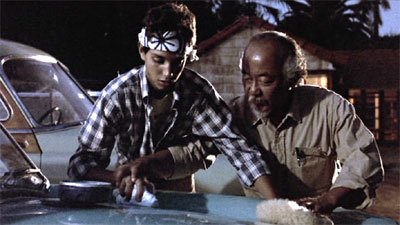
The film builds to the expected climax, though how it arrives there isn't quite as predictable. The road to the end is quite exciting, all the while creating real characters out of Macchio and Morita's parts. A romantic subplot between Daniel and Ali is cute, but as one learns quickly, there's no room in Daniel's life for a steady relationship. The key dramatic theme is in Mr. Miyagi's life, as Daniel discovers things his mentor never told him, which builds a level of understanding between them. Morita's steadying influence on the film and his perfect understanding of where Miyagi is coming from helped earn him an Oscar nomination for the role.
All this time later, it's impossible to imagine this movie without Macchio and Morita, as they were as close to exact as one could ask for. The dialogue has some cheesy moments and the plot can meander while working on the Daniel/Ali storyline, but in the end, it's a solid film that just about anyone can enjoy.
The Karate Kid II: This movie picks up just after the events of the first film, which are uniquely replayed at the beginning of the second. With Daniel's bully problems over and college ahead, the story shifts to Miyagi's life. His father is on his deathbed back in Okinawa, but returning means running into his old rival, Sato, and Yukie, the woman he left behind when he left the island. Of course, Miyagi's a bit too old to be the Karate Kid, so Daniel tags along to see Okinawa.
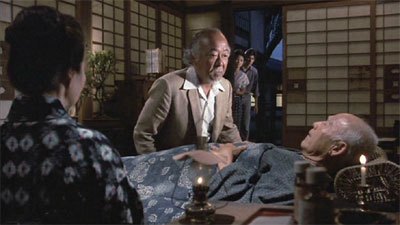
As Daniel quickly finds out, grudges transcend generations, and Miyagi's rivalry with Sato becomes Daniel's rivalry with Sato's protégé, Chozen. That Danny has caught the eye of Kumiko, one of the island's most beautiful girls, doesn't thrill Chozen either. So as Sato and Miyagi work out their issues, Daniel's war is just getting started, reaching its height in a dramatic rescue during a monsoon, that leads to a face-off between the two young karate masters. The creators couldn't go back to the crane-kick well, so a new technique is introduced that plays a big part in the final battle.
Though weaker than the first movie, there are some extremely memorable moments, including the ice-breaking scene and the tea ceremony, which seems to be included to fill some cultural quota. Miyagi gets plenty of screen-time, as this is more his story than Daniel's. The themes of responsibility and regret reverberate loudly in his portions as he tries to defend his village and regain what he once lost with Yukie.
The Karate Kid, Part III: The final part of the Daniel-San trilogy takes place shortly after the second film, as Miyagi and Daniel return from Okinawa. Kreese has lost everything after his actions in Part II, but a fellow Cobra Kai, Terry Silver, who fought alongside Kreese in Vietnam, is there to help. A millionaire thanks to his chemical company, Silver has a plan to re-launch Cobra Kai karate schools and help his old buddy get revenge on Miyagi and Daniel.
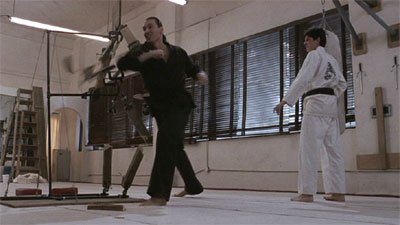
Meanwhile, when Miyagi returns, he finds his old employer, the South Seas, is being torn down. Daniel has the brilliant idea to use his college money to bankroll a bonsai business for his teacher, which starts off well, but ends up in trouble. A rare bonsai plant that Miyagi brought with him to America from Okinawa when he first arrived could be the answer to their money problems, but Daniel screws that up, causing some guilt and friction for Daniel.
This movie is something like the Return of the Jedi of the series, as Silver's plan is to trick Daniel into giving himself over to the "dark side," exchanging Miyagi's technique and philosophy for Silver's anger and rage. Miyagi's unwillingness to allow Daniel-san to defend his title against "Karate's Bad Boy," Mike Barnes, only serves to push him closer to Silver and away from his friend. Of course, once again there's a cute girl (this time it's Robyn Lively) who tries to center him, but it will fall to Daniel to make the right decision.
Of the villains in the first three films, Terry Silver is easily the most cartoonish, from his maniacal laughter to his ridiculous bad-guy background (his company, Dyna-Tox (as in toxic), makes money from dumping chemicals in poor countries). As a result, it gets hard to take the film as seriously as the other two. The plot is just a bit too out there. It's in this film that you finally realize that Daniel can't win a fight outside of the final 10 minutes and that no one can even lay a finger on Miyagi. Considering how the series standards were wearing thin, I guess it's good that this storyline died after three films, instead of stretching it out for an embarrassing fourth outing.
Oh, wait...
The Next Karate Kid: This movie is a special treat, as it's actually an interactive film. As you watch it, you'll find yourself saying out loud, "What the hell were they thinking?" and "Am I on drugs?" You won't get any answers, but the film will respond with an even more ridiculous moment to inspire further comments from you. And just when you think you've seen the most outlandish scene you could see, the filmmakers pull another piece of retarded magic out of their hats. If I had a nickel for every time I said "Oh my God..." I could probably top Next's box office gross. Let's just say, the final act involves flaming barrels, an explosion, bungee jumping and a prom. If that doesn't pique your interest in this film, nothing will.
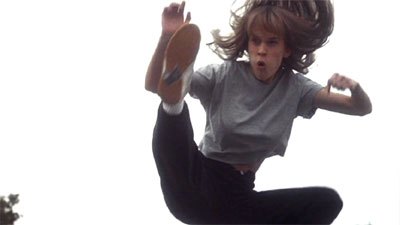
(Reviewer's note: I just watched the bungee jumping scene again, and I can only figure the writer has just had dental surgery, and was on heavy painkillers. There's no logical explanation for what goes on in this scene.)
Mr. Miyagi has come to Boston to accept an honor for his service to America, which brings an opportunity to reconnect with Louisa, the wife of the man who saved his life in combat. She is now burdened with raising her granddaughter, Julie (Hilary Swank), who lost both her parents in a car accident. As a result, she is sullen and rebellious, two personality problems that are wearing on her grandmother. Miyagi steps in to help out Louisa, sending her off to California to relax at his garden home, while he attempts to straighten out Julie. After working his magic on Daniel-san, Julie-san shouldn't be too tough.
Obviously, Miyagi doesn't know girls very well. Dealing with Julie allows him to spout his fortune-cookie philosophy, while trying to learn about the rough-edged teen. Her troubles only multiply when she runs afoul of the school administrators, thanks to the hidden, injured hawk she's taking care of (!), and gets suspended. With some time on her hands, Miyagi takes her to a monastery (nearby to Boston apparently) to study karate with some monks. Then they go bowling. And to the prom. And a dock fight.
The main villain of the film, a neo-fascist teen named Ned, is the kind of bad guy Ben Stiller would play, full of over-the-top ego and pithy quips. As the leader of the Alpha Elite, a black-clad high-school Gestapo, he follows orders from Col. Dugan, who is played with all the subtlety of a nail in the eye by Michael Ironside (Starship Troopers). With violence as his sole motivational technique, he puts together a stormtrooper squad of hall monitors. Of course, Julie becomes a main target for the group, particularly Ned, who has "romantic" intentions for her. So when she becomes interested in a former member of the group, things only get worse, leading to a climax that is more laughable than dramatic.
Truthfully, to explain all the insane bits of plot that make up this film would mean ruining the experience and risking brain damage on your part and your humble reviewer's as well. Fans of the original films will notice plenty of callbacks in Next as the film becomes a blender-mix of plotlines, references and insanity. I'm almost tempted to say this is a must-watch, but it really is bad. One has to view it with some heavily suspended disbelief. It's worth noting that instead of being created Avildsen and Kamen, Christopher Cain (Young Guns) and Mark Lee took over, so it only makes sense that the feel of the series would be lost. Considering what this film did to the franchise, it's probably lost for good.
The DVDs
Columbia/Tri-Star has released the four Karate Kid movies in a three-disc collector's set, making it the only way to get any of these films. The set includes three discs, with the third and fourth films sharing a two-sided flipper DVD. Oddly, the flipper seems to be mislabeled. If the DVD is inserted with the label for The Next Karate Kid facing up, The Karate Kid, Part III will play. Traditionally, at least in my experience, whichever side is facing up is the side that plays. The three discs are packaged in ThinPak cases, which are housed in a cardboard slipcase. Each ThinPak's cover is similar to a standard DVD release, with specs, artwork and a synopsis (two in the case of the third disc.) The inside of the ThinPak cover features a nicely-designed, though empty karate-inspired look. This area would have been the perfect spot for chapter-stop lists, but there are none, as there are no inserts.
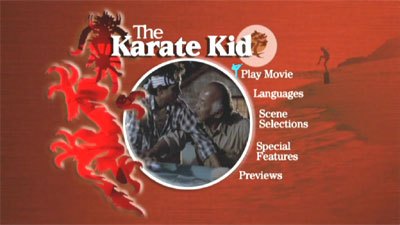
Here's a breakdown of the disc-specific information:
The Karate Kid: As the only special edition disc in this collection, the first film gets the best treatment, with an attractive, animated, anamorphic widescreen main menu that holds options including languages (English and French 2.0), subtitles (English, Spanish, French, Chinese and Thai), scene selections, special features and previews. The scene selection menus, themed around Daniel's fly-catching, include still previews and titles for each chapter stop.
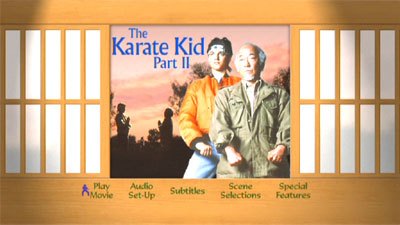
The Karate Kid II: Part II has static anamorphic widescreen menus, using images from the film and a tea-ceremony theme. Included in the options are audio set-up (English, French, Spanish and Portuguese), subtitles (English, Spanish, French, Portuguese, Chinese, Korean and Thai), scene selections and special features. The scene selection menus have still previews and titles for each chapter.
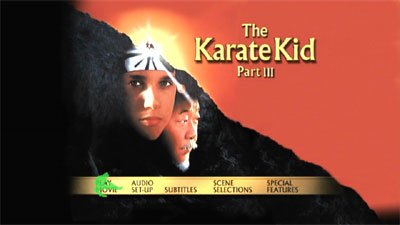
The Karate Kid, Part III: The third entry has static anamorphic widescreen menus, themed after the movie. The options available are audio set-up (English, French, Spanish and Portuguese), subtitles (English, Spanish, French, Portuguese, Chinese, Korean and Thai), scene selections and special features. The scene selection menus have still previews and titles for each chapter.
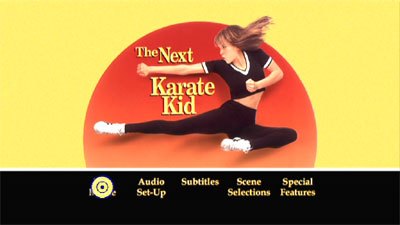
The Next Karate Kid: The series' red-headed stepchild has static anamorphic menus as well, though not nearly as well designed as the others, with audio set-up (English, French, Spanish and Portuguese), subtitles (English, Spanish, French, Portuguese, Chinese, Korean and Thai), scene selections and special features. Like the other discs, the scene selection menus have still previews and titles for each chapter.
The Quality
When I first received these discs, I popped them into my player immediately, because I wanted to clear up some confusion as to the movies' aspect ratios, soundtracks and special features. First thing I noticed was the video bitrate, which averaged a very low 4Mbps. I've read that Columbia/Tri-Star has done this in the past to avoid using dual-layer DVDs, which is beyond disappointing. Going cheap on disc space is a crime against DVD. Though the bitrates are low, the quality doesn't seem to suffer greatly because of it.
The first film, made in 1984, has plenty of grain and occasional dirt, but it's not a constant problem, as mainly night scenes, and shots with large areas of solid color displayed the grain in a conspicuous way. I knew how to establish the quality right away, and that was to check out the scene following the Halloween dance, where Daniel is chased by the Cobra Kai. The scene is loaded with shadows and fog, a cold blue palette and an overall dark look. Amazingly, this is perhaps the best looking scene in the film. Details are clear, the color is correct and the grain isn't nearly as bad as in other scenes. The movie could look better, especially for a film remastered in high-definition, but it's definitely looked worse, as one peek at the film's trailer illustrates clearly.
The audio, presented in Dolby Surround 2.0, does the trick, and seems to fit the film just right. The two channels isolate the dialogue and make the music, a key component of the movie, much more of an enveloping experience.
The second movie, also remastered for HD, looks even better, though dirt and grain are evident once again. It's not an overwhelming problem, but it will be noticed. Scenes using visual effects are obvious, a result more of the technology of the day, rather than the presentation. There's a soft feel to the film in certain scenes, but then in others the details can be razor sharp. Overall, considering the age of the source material, this is a rather acceptable transfer, with good color ad very good detail.
The soundtrack, once again done in Dolby Surround 2.0, makes for a good listen, with some slight ambient sound effects enhancing the clear dialogue and music.
The third film, the second most recent in the series, actually looks the worst of the bunch in some ways, despite being mastered in HD. The amount of dirt and damage on this transfer is wholly unacceptable after seeing the first two films. Take a look at the scenes that take place in the sea caves, and you will see a film that looks to have been through a shredder. It's not all as bas as those scenes, but there are some problems. The detail is much sharper in this movie than in the previous two, with very good color. Much of the film takes place at night, and there are no notable problems with definition, which makes it better than it might have been with its issues with transfer damage.
I could just repeat myself, but the third film's soundtrack is the same as the other two, encoded for Dolby Surround 2.0. There's nothing about this presentation to complain about.
As would be expected, the fourth film looks the best, having been mastered in HD more recently. As seems to be the style for these movies, there's plenty of darkness, and that doesn't hurt the film a bit. Colors are spot-on, fine detail is very good (check out the bricks in the school courtyards for an example) and there's hardly any dirt or damage to be found. Since the third film had such issues, I was certain to check the bright blue sky shots for noise and dirt, but can't say I found much. Upon close examination, edge enhancement can be found, but it doesn't distract much.
As with the previous three films, the Dolby 2.0 soundtrack is nice, but as this movie was released in the '90s, I would think the materials for true surround sound should be available. If they are, this soundtrack is a gyp, but as it is, it sounds good.
The Extras
The bonus features included differ from disc to disc. Here's what you'll find on each platter:
The Karate Kid:The big bonus feature on this disc is the audio commentary with Avildsen, Kamen, Macchio and Morita. The foursome works well together when it comes to telling stories about the film's production, while cracking plenty of jokes, adoring Shue and sharing plenty of trivia. It's obvious right off the bat that this movie means a great deal to the four men, but at the same time, they don't take it too seriously, poking fun at many aspects of the film. If you ever had a question about part of this movie, it's more than likely answered here. The on-screen descriptions are kept to a minimum and there's not a lot of "aren't they great" moments, which leaves them plenty of time to tell stories like Avildsen's cringe-worthy moment with a limo greeter. This is a great listen for fans of The Karate Kid.
While the commentary is all-encompassing in terms of information, thankfully the DVD doesn't stop there. Five reasonably lengthy featurettes go in-depth on four topics in the film, and are all presented in anamorphic widesceen. "The Way of the Karate Kid" parts one and two focus on the making of the film, mixing on-set video, new interviews with the main cast members (including Macchio, Morita, Zabka and Kove), the writer and the director, and film clips, to follow production from the page to today. Clocking in at over 45 minutes, the two featurettes reveal just how much went into making a film that doesn't get much respect today outside its cult of admirers. Proper notice is made of how much a part of American pop culture this film is today, as there are few people who don't know what "Wax on, Wax off" means, or who haven't taken the crane kick position, one time or another. The ending is quite touching, possibly the most touching a DVD featurette focused solely on a film has ever been.
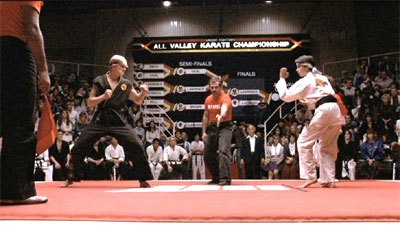
"Beyond the Form" puts the spotlight on Pat E. Johnson, a master karate expert and fight choreographer, who put Daniel LaRusso through his paces. Johnson has worked with the greatest martial artists in the world, including Bruce Lee and Jackie Chan, but views The Karate Kid as the film he loves the most. His extremely thoughtful observations on karate and filmmaking, and the differences between Miyagi and Kreese's teaching style, give the film another level of meaning. These thoughts are punctuated with clips from the film, as well as footage and photos of Johnson on the set working with the actors. This is fascinating for anyone interested in stunt work, martial arts or simply this movie.
Another informative and personal featurette, "Life of Bonsai" follows Ben Oki, a master bonsai artist, as he walks through his garden. As he introduces his bonsai creations, he covers the basics of the art, imparting his philosophy. Considering the importance of bonsai in this series, and how the movies helped make bonsai a part of American culture, this is a very appropriate and enjoyable extra.
Also included is "East Meets West: A Composer's Notebook," which focuses on musician Bill Conti's contributions to the film. There's a tremendous amount of information about how music and film go hand-in-hand, and how that music is created, as Conti tells all about his scoring of the movie. For myself, learning about who was behind the movie's signature Asian-inspired training theme was the most interesting bit, but that's not all there is to watch and listen to. Running at a combined 76 minutes in all (a "play all" option is available), these features are a great addition for any fan of the Kid.
Three trailers are also included, for The Karate Kid, The Karate Kid II and 3 Ninjas High Noon at Mega Mountain. The Karate Kid preview is in grainy, dirty full-screen, while Part II is in slightly better condition, though still full-screen. The less said about that third one, the better.
The Karate Kid II: Though the packaging lists an Interactive DVD-ROM Game (which seems to have been moved to the fourth film), this disc's bonus features include a featurette, text filmographies for Avildsen, Macchio and Morita, and trailers for The Karate Kid, The Karate Kid II, Godzilla 2000, Roughnecks: Starship Trooper Chronicles: The Pluto Campaign. Godzilla 2000 is in widescreen and Roughnecks is full-screen.
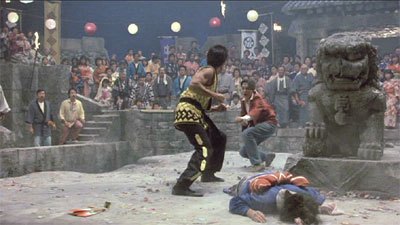
The full-screen featurette is vintage in quality, opening with the climax of the first film. An EPK-ish production running around six minutes in length, it is made up of footage from the second film and interviews with the cast and crew. As a bit of history, it's interesting, but it's no more in-depth or interesting than your standard studio-produced fluff.
The Karate Kid, Part III: Just two sets of extras on this film, with filmographies for Avildsen, Morita and Macchio, and the same trailers as Part II, plus a full-screen preview for Beverly Hills Ninja. Considering that you can't buy these discs separately, why repeat the content? Plus, where is the trailer for Part III?
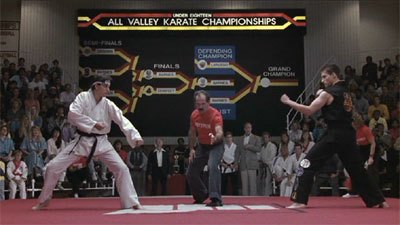
The Next Karate Kid: There are two extras on this disc as well, but only one will work on your DVD player. Two text filmographies, one each for Morita and Swank, are available on this DVD. Pop this side into your DVD-Rom drive, and a flash entrance will open, allowing you to play three Miyagi-themed games: catching flies with chopsticks, outdriving the bad guys and catching falling bonsai plants. They are cute, but you won't play them too often, as the controls are clunky. There are also links to Columbia and Sony's websites, and a play movie option, but that wouldn't work on my machines. One question remains: no trailer for The Next Karate Kid? What gives?
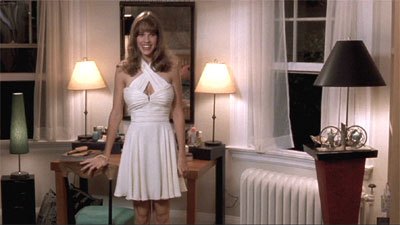
The Bottom Line
For the average Karate Kid fan, the Swank-headlined fourth film doesn't count, so just consider it a bonus you might not even watch. That same fan though should be happy to have the original trilogy on widescreen DVD though. Overall, Columbia/Tri-Star has put together a decent package, finally giving the first film the special-edition treatment it deserves. Unfortunately, the low video bitrate and a low-tech sound mix make for a presentation that's less than hoped for. The enjoyable extras on the first film, and the fact that all the films are in anamorphic widescreen make this an easy recommend, but one that could be better. Fans of Daniel-San can purchase this set without hesitation.
Francis Rizzo III is a native Long Islander, where he works in academia. In his spare time, he enjoys watching hockey, writing and spending time with his wife, daughter and puppy.Follow him on Twitter
*The Reviewer's Bias section is an attempt to help readers use the review to its best effect. By knowing where the reviewer's biases lie on the film's subject matter, one can read the review with the right mindset.
|
| Popular Reviews |
| Sponsored Links |
|
|
| Sponsored Links |
|
|
| Release List | Reviews | Shop | Newsletter | Forum | DVD Giveaways | Blu-Ray | Advertise |
|
Copyright 2024 DVDTalk.com All Rights Reserved. Legal Info, Privacy Policy, Terms of Use,
Manage Preferences,
Your Privacy Choices | |||||||













